In the Constitution, Congress is charged with providing for the general welfare of the country’s
citizens. Historically, this has meant improving transportation, promoting agriculture
and industry, protecting health and the environment and seeking ways to solve social and
economic problems. In 1956, Congress passed the Federal-Aid Highway Act, popularly known as the National Interstate and Defense Highways Act, authorizing federal funding for the extension and
construction of a robust network of interstate highways. This project was one of the largest public
works in U.S. history establishing key transportation infrastructure that impacted lives of all
Americans — changing communities, access and economic possibilities and also providing key
routes for evacuating urban centers — a critical national defense issue in the Cold War era.
Analyzing primary source material, students discuss the origins and reasons for the National
Interstate and Defense Highways Act. Then, they work with historical and contemporary maps
as they consider the impact this important congressionally funded project. While intended for 8th
grade students, the lesson can be adapted for other grade levels.
Bill of Rights
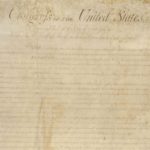
The Bill of Rights is on permanent display at the National Archives in Washington, DC. This original joint resolution of Congress proposed 12 amendments to the United States Constitution, but only 10 were ratified. Added to the Constitution in 1791 as the first 10 amendments, the Bill of Rights explicitly protected freedom of speech, of the press, of religion, and of assembly, among many other rights.
Constitution of the United States
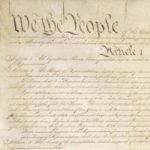
The original U.S. Constitution is on permanent display at the National Archives in Washington, DC. Drafted in 1787 after a hard-won victory in the War for Independence, this document codified the spirit of the Revolution into an ingenious practical scheme of government to promote the welfare of all its citizens.
Congress and the Creation of the Bill of Rights
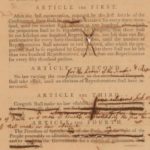
Students will explore the protections and limitations on authority contained in the Bill of Rights and the process by which the First Congress created it. They will do this by compiling a list of their rights as students, analyzing the Bill of Rights, and studying primary source documents to trace the origin and development of the first ten amendments. Students will then consider how the Bill of Rights might be updated to reflect 21st century circumstances. (Duration: 30–90-minute segments, up to 5 hours.)
Defenders of Liberty: The People and the Press
This lesson plan is based on the Annenberg Classroom video “Freedom of the Press: New York Times v. U.S.,” which explores the First Amendment’s protection of a free press as well as the historic origins of this right and the ramifications of the landmark ruling in the Pentagon Papers case in which the Supreme Court ruled that prior restraint is unconstitutional.
The 1964 Civil Rights Act: Lesson Plans and Resources
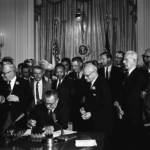
On July 2, 1964, President Lyndon B. Johnson signed the Civil Rights Act into law. Originally proposed by President Kennedy in 1963, this landmark piece of legislation made discrimination based on race, religion, sex or national origin illegal. Additionally, the Civil Rights Act ended the practice of unequal voter requirements based on race or sex and ended racial segregation in schools. The Share My Lesson team has curated a collection of free lesson plans, activities, and classroom materials for educators to use in teaching students about the Civil Rights Act.
The Constitution in Action – Origin of the Bill of Rights: State Amendments
History is the chronicle of choices made by actors/agents/protagonists in specific contexts. This lesson places students at a critical moment in our nation’s founding, when Americans considered whether to ratify the Constitution. Should they agree to the document as-is, without making any changes? Students will examine and evaluate numerous amendments proposed at state ratifying conventions. Only by looking at the full sweep of amendments offered by the states can students understand the historical context of the Bill of Rights.
Anishnabe/Ojibwe/Chippewa: Culture of an Indian Nation
This lesson provides information and activities about one American Indian Nation, the Anishinabe, called Ojibwe in Canada and Chippewa in the U.S., and engages students in research on its history, location, and past and present culture.
Freedom of the Press: New York Times v. United States
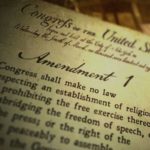
This documentary examines the First Amendment’s protection of a free press as well as the historic origins of this right and the ramifications of the landmark ruling in New York Times v. United States in which the Supreme Court that prior restraint is unconstitutional. The federal government could not prevent newspapers from publishing the Pentagon Papers. A lesson plan, Defenders of Liberty: The People and the Press, accompanies the video.
